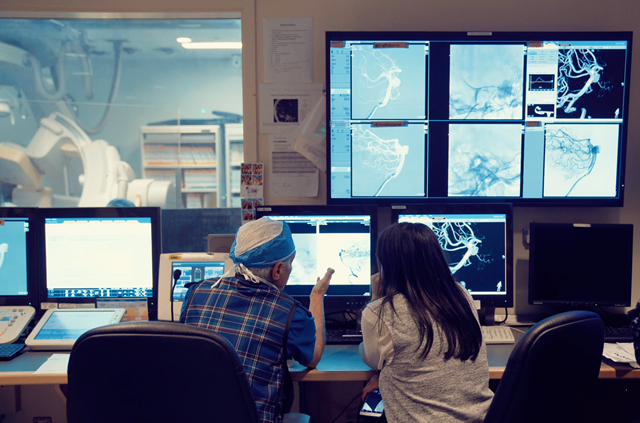
By Roger Boyle
Over 62,000 strokes occur in Canada each year, and for patients, access to treatment is critical to survival and improved recovery.
In November, the Neuro Interventional Radiology team at the University Health Network’s (UHN) Toronto Western Hospital took the first step towards enabling greater access to stroke treatment by performing the first-in-human robot-assisted neuro interventional procedure, with a remote operation system.
“Precision is a key element of neurovascular interventions,” says Dr. Vitor Mendes Pereira, neuroradiologist with UHN’s Joint Department of Medical Imaging (JDMI), and neurosurgeon, Krembil Brain Institute. “We recognized that the robotic system could immediately bring an added level of precision in treating this patient, reducing the risk of an aneurysm rupture, and enhancing quality of care.”
“This is currently the only robotic system in the world capable of this type of neuro interventional procedure, and we knew it could help in our treatment of the patient.”
The landmark robotic-assisted aneurysm case marked a significant milestone in interventional medicine as the first step in building towards a new treatment paradigm for patients suffering from neurovascular disease.
 During the procedure, Dr. Pereira led the intervention from a control station with joysticks in hand to maneuver the robotic arm. Through the digital controls, he guided a micro catheter with millimetric precision through vessels in the brain and deployed a coil, limiting blood flow to the aneurysm.
During the procedure, Dr. Pereira led the intervention from a control station with joysticks in hand to maneuver the robotic arm. Through the digital controls, he guided a micro catheter with millimetric precision through vessels in the brain and deployed a coil, limiting blood flow to the aneurysm.
Fellow neuroradiologists, Drs. Timo Krings and Patrick Nicholson, provided bedside physician support while medical radiation technologist, Nicole Cancelliere, acted as the bedside robotic technician.
Prior to the procedure, Dr. Pereira performed a rehearsal on a 3D-printed model with the exact anatomy of the patient, a 64-year-old female. Using the model allowed Dr. Pereira to develop a plan for the novel robotic procedure and ensure an optimal treatment approach.
“I knew what I wanted to do going in,” says Dr. Pereira. “Some of the steps that could be trickier were anticipated, and knowing what to expect gave us added confidence to ensure the procedure’s success.”
The importance of this type of clinical advancement is closely connected to the success of endovascular procedures for stroke treatment over the past 10 years. With modern techniques, dedicated stroke treatment centres are able to half the mortality rate of stroke patients, and double the rate of independent living in successful treatment outcomes.
“Theoretically with this type of treatment, will we be able to bring the necessary clinical expertise to the patient, instead of bringing the patient to our hospital,” says Dr. Krings, Division Head of Neuroradiology, JDMI and Site Chief, Medical Imaging, Toronto Western Hospital. “We believe this is the first step towards performing remote neuro interventional procedures, especially in rural areas of Canada where there is limited access to timely ischemic stroke care.”
As next steps, JDMI’s Neuro Interventional Radiology team looks to test remote procedures on 3D –models through local connections between hospitals and develop an established protocol for true remote interventional procedures.
“Stroke is a disease where time is essential,” says Dr. Pereira.
“If we can reduce the time we spend transferring patients, and begin to offer remote access for stroke treatment anywhere, we can bring a new level of expert care to patients in need.”
Roger Boyle is a communications consultant at University Health Network.

